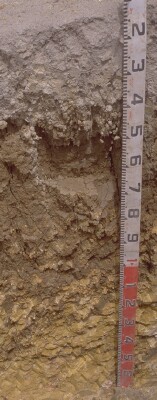SW75
Location: Tulloh
Australian Soil Classification: Bleached-Vertic, Eutrophic, Brown CHROMOSOL
General Landscape Description: Undulating low hills.
Site Description: Waxing upper slope; 10%; eastern aspect.
Geology: Tertiary sediments (either Dilwyn or Eastern View Formation).
Soil Profile Morphology:
Surface Soil
| A1 | 0-15 cm | Dark grey (10YR4/1 moist), grey (10YR5/1 dry); loam; weakly pedal; pH 5.4: |  SW75 Profile. Note: Surface (A1) horizon has been stripped from the soil profile |
| A2e | 15-40 cm | Yellowish brown (10YR5/4 moist), conspicuously bleached (10YR8/3 dry); loam; massive; some weak (breaking with moderate force) ferruginous nodules (<15 mm); pH 5.7; abrupt and wavy change to: | |
| Subsoil | |||
| B1 | 40-50 cm | Pedal structure, angular blocky, parting to polyhedral structure; pH 5.8; clear change to: | |
| B21ss | 50-100 cm | Brown (10YR4/3 moist); heavy clay; irregular coarse (100 mm) prismatic, parting to medium (20 mm) prismatic, parting to angular blocky structure; strongly vertic; slickensides prominent (up to 1 m); very sharp angles on prisms; structure; pH 6.0; gradual and wavy change to: | |
| C/B | 100 cm+ | Yellowish brown matrix (10YR5/8 moist), with dark brown clay lenses; very weathered and friable; fine white material sometimes associated with lines of weakness; pH 5.8. |
Key Profile Features:
- Conspicuously bleached subsurface (A2) horizon.
- Strong texture contrast between surface (A) horizons and subsoils (B2) horizons.
Soil Profile Characteristics:
pH | Salinity Rating | |||
Surface (A1 horizon) | Strongly Acid | Low | Non-Sodic | None |
Subsoil (B1 horizon) | Moderately Acid | Very Low | Non-Sodic | None1 |
Deeper Subsoil (at 50-100 cm) | Moderately Acid | Very Low | Non-Sodic | None |

| The surface soil is strongly acid. The subsoil is moderately acid. | Salinity rating is low in the surface becoming very low in the subsoil. |
| The clay content increases markedly at the A/B boundary. |
Horizon | Sample Depth (cm) | pH (water) | pH (CaCl2) | EC 1:5 | NaCl % | Exchangeable Cations | |||
Ca | Mg | K | Na | ||||||
meq/100g | |||||||||
A1 | 0-10 | 5.4 | 4.6 | 0.08 | 3.1 | 1.3 | 0.14 | 0.1 | |
A2 | 20-40 | 5.7 | 4.9 | <0.05 | 1.8 | 1.4 | 0.11 | 0.07 | |
B1 | 40-50 | 5.8 | 4.9 | <0.05 | 3.4 | 4.6 | 0.28 | 0.17 | |
B21ss | 60-80 | 6 | 5.2 | 0.08 | 3.7 | 10 | 0.13 | 0.54 | |
C/B | 140-160 | 5.8 | 4.9 | 0.06 | <0.01 | ||||
Horizon | Sample Depth (cm) | Exchangeable Aluminium mg/kg | Exchangeable Acidity meq/100g | Organic Carbon % | Nitrogen % | Field Capacity pF2.5 | Wilting Point pF4.2 | Coarse Sand (0.2- 2.0 mm) | Fine Sand (0.02- 0.2 mm) | Silt (0.002- 0.02 mm) | Clay (<0.002 mm) |
A1 | 0-10 | 38 | 14 | 4.4 | 0.34 | 26.3 | 8.5 | 16 | 42 | 20 | 14 |
A2 | 20-40 | 12 | 6.8 | 19.6 | 7.7 | 16 | 40 | 20 | 22 | ||
B1 | 40-50 | 26 | 32.7 | 20 | 6 | 21 | 13 | 58 | |||
B21ss | 60-80 | <10 | 13 | 48.7 | 31.7 | 1 | 5 | 7 | 83 | ||
C/B | 140-160 |
Management Considerations:
Notes
- Ferruginous nodules/buckshot in A2 has soft centres and can be broken with moderate force.
Profile Described By: Richard McEwan (April 1999).


